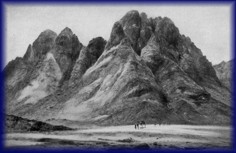 |
A path through the sea |
 |
|
STEVE RUDD, THE CHIEF PROPONENT OF A STRAITS OF TIRAN CROSSING, rejects the Nuweiba beach crossing on the grounds that, There is simply no place to locate Etham because the beach is so tiny, (28 sq. km.) that Israel would take up all available space. There is no place on the Nuweiba Beach for God to tell them to retrace their path back to the red sea crossing point, forcing them to return again to the actual crossing point they passed the day before. In other words, the area is so small, that once you squeeze 2-3 million people with flocks and herds on the beach, there certainly is no room for them to go to another location (Etham) then return again.1 His reasoning is based on a rather bizarre interpretation of the "turn" at Etham (Ex. 13:20-14:4). He believes that the turn was a U-turn. In his scenario, the Israelites blundered right past the Red Sea crossing point and came to a dead-end at Etham where mountains rise from the flat. God had to instruct them to retrace their steps back to the crossing point. He then imposes this interpretation on Nuweiba Beach and shows that it just doesn't fit. This supposed objection to a Nuweiba crossing point simply melts away when you understand that the "turn" refers to a change in direction from Etham in order to take them to Pi-hahiroth (Nuweiba) rather than a retracing of steps from Etham back to the crossing point. His interpretation faces a serious problem; it suggests God led them to overshoot the mark. Does God blunder? The same author goes to great lengths to also present the Nuweiba crossing as impossible, adding, The Straits of Tiran provide a max depth of 205 meters and are clearly a far superior choice for where Israel crossed the Red Sea.2 However, contra Steve Rudd, the Straits of Tiran would not appear to serve as a viable crossing point at all: In the midst of the Strait of Tiran is the Enterprise Passage [See Map 2, taken from the NOAA map 62222]. This is an underwater passage / channel that goes north south through the Strait. It is approximately ¾ of a mile wide with a depth of 700 feet. The eastern side has a slope with at least a 60% incline. The 60% would be an extremely difficult, if not impossible, obstacle for travel. One of the proponents acknowledges this depth, but does not seem to grasp the significance of the problem (Cornuke and Halbrook 2000:214). It would be a near impossible process for 2 million people to go down and up these slopes, along with their carts and wagons.3 As best this author can tell from checking the above-mentioned chart, the slope from the bottom of the Enterprise Passage up onto the Gordon Reef would be one in 2.4 (a climb of 750 feet up from the bottom across a passage 1800 feet wide). That is, one step up for every 2.4 steps across, which makes an incline of 23º. (What Gordon Franz means when he talks about a slope of 60% is unclear.) That is indeed quite steep and would present a challenge. Unfortunately, this author was unable to find data on rating climb difficulty based on slopes, and cannot say with confidence just how difficult a climb that would be. How about the Nuweiba-Midian crossing? A combination of depth data and simple trigonometry shows that a crossing here would be a fairly straightforward affair. The width of the sea at this point is around sixteen kilometers (ten miles), dropping to a depth of 780 meters (2550 feet) slightly east of the midway point. Using a trigonometric calculator4shows that a drop to a depth of 780 meters across a horizontal distance of 8000 meters translates into a slope of less than six degrees! Can you grasp the significance of that fact? The slope down to the deepest part of the sea from Nuweiba averages a tad under 6º which is, of course, mirrored on the far side by an average upward climb of a tad over 6º. More detailed studies suggest that at the ¾ mark the slope increases for a short distance to about 14º. Bearing in mind that slopes for wheelchair access are set by most county regulators at 4.8º (one in twelve), an average slope of 6º would challenge nobody. Pharaoh entertained no qualms about driving his chariots across. I'm not so sure he would have relished a 23º slope at the Tiran Straits. No law of the universe says they had to walk in a straight line, either. They may well have snaked their way across, skirting around any steeper sections they may have encountered. In short, the Straits of Tiran has little to commend it over Nuweiba Beach as a crossing point, except that it is shallower and would require a shorter walk. But hey, who wants to minimize the miracle?! Before we leave the Straits of Tiran for good, one further factor needs to be considered in helping determine which crossing point - Straits of Tiran or Nuweiba Beach - is the more likely. Scripture provides some helpful details concerning the crossing: Then Moses stretched out his hand over the sea; and the Lord caused the sea to go back by a strong east wind all that night, and made the sea into dry land, and the waters were divided. So the children of Israel went into the midst of the sea on the dry ground, and the waters were a wall to them on their right hand and on their left. And the Egyptians pursued and went after them into the midst of the sea, all Pharaoh's horses, his chariots, and his horsemen. Now it came to pass, in the morning watch, that the Lord looked down upon the army of the Egyptians through the pillar of fire and cloud, and He troubled the army of the Egyptians. And He took off their chariot wheels, so that they drove them with difficulty; and the Egyptians said, "Let us flee from the face of Israel, for the Lord fights for them against the Egyptians." (Ex. 14:21-25). Try to grasp what is going on here. Some interpret this passage to be suggesting that the waters divided as a result of wind coming out of nowhere at the very moment the Israelites started wading into the water: The Israelites suddenly found themselves hemmed in by the Sea of Reeds. on one side and the Egyptian army on the other. At that critical moment, they are told by God to advance into the sea. As they do so, the waters part, allowing the Israelites to cross over to the other shore (Shanks, p. 40). This scenario forgets the fact that the pillar of cloud and fire came between the Israelites and the Egyptians, preventing the Egyptians from advancing any further until everything was prepared for them. It also makes mincemeat of commonsense. For the Israelites to be nearing safety on the opposite shore while the Egyptians were flailing away some distance behind would require that the Israelites had had a big head start. It also distorts the plain meaning of this passage, which must surely be read to mean that the wind blew all night while the Israelites were ensconced in their tents on the beach. When they woke the next morning they were greeted by an unprecedented and never-repeated sight - a dry path through the sea. The passage strongly implies that some time that day the Israelites received the order to take the low road right into the abyss, the Egyptians all the while being held back by the impenetrable cloud of darkness. The Israelites struck out sometime during daylight and were still walking in the wee hours of the morning, with the tailenders pulling up onto the opposite shore some time during the "morning watch", with their foes in hot pursuit. The morning watch was the last of the three watches into which the night was divided (Sherman, p. 373), equating to roughly 2:00 am to 6:00 am. Admittedly, the argument presented here is based on a degree of ignorance due to the impossibility of knowing exactly what time of day the leading band of Israelites began walking and how wide the passage was. We cannot, therefore, know how many Israelites (not to mention cattle) could march abreast. Ergo, we cannot know how long it would have taken the entire mass to reach the far side. But surely they would have begun walking by mid-afternoon, and were pulling onto the beach by about 4:00 am. They must have had at least 12 hours, and maybe 16 or even more as a group to cross. Even with a considerable lag between leaders and tail-enders - say, four to six hours - each individual could have walked for a good six to eight hours. Such a walking time argues for a longer crossing against a shorter crossing. The stretch across the Straits of Tiran to the first area of dry land is only about 5.8 miles, a walk that could have been accomplished in four hours by an individual with great ease even on a slope (assuming it was a negotiable slope, which it may not have been across the straits). Add four to six hours between leaders and tailenders (bearing in mind the earlier disclaimer) and you have a total of eight to ten hours for the entire troop to cross. The Gulf of Aqaba between Nuweiba and the opposite shore, by contrast, is around ten miles wide. A Nuweiba crossing seems to fit the biblical data very comfortably. Furthermore, the Straits-of-Tiran crossing faces a fatal objection. Numbers 33:8-10 reports that after the Israelites had passed through the sea, they struck out into the wilderness for three days before arriving at Marah. After Marah, they camped at Elim. And then — and this is vital — they once again camped alongside the Red Sea! Look at Google Earth for yourself. Can you figure out any path that would have taken them far from the Red Sea, only to bring them back to it again? It makes no sense at all. By contrast, the route proposed in this paper makes perfect sense of this crucial fact. One can have no vested interest in putting a crossing at one site ahead of the other. If it did take place at the Straits of Tiran, excellent. But as this Dawn to Dusk paper brings out, putting all the evidence together points strongly to a Nuweiba Beach crossing.
3 The Chronology from Rameses to the Red Sea |
|
|
|
Dawn to Dusk publications |
Other printed material |
On the Web |
|
|
|
| Edited and expanded copies of this article, in reprint pamphlet form, can be purchased by going to the reprints order page. As well as reprints, Dawn to Dusk offers books in printed form and on CD-ROM. We mail to anywhere in the world! For more information on what is available, prices, and how to order, click the icon. |